Photo Essay
Some Historical Images of Health Care in New Brunswick
P194-1403: Outdoor portrait of five people affected by leprosy at Tracadie, NB, [1885–1900]. A lazaretto operated in Tracadie
from 1849–1964. “Do not call before ten, do not touch anything they have been using, do not even sit down upon their chairs,
above all do not inhale their breath” (Dr. A.C. Smith, resident physician at the lazaretto).
 Display large image of Figure P194-1403Mounted albumen print (cabinet card) by G.A. Burkhardt.
Display large image of Figure P194-1403Mounted albumen print (cabinet card) by G.A. Burkhardt.
Image provided with permission of the Provincial Archives of New Brunswick.
P194-364: Studio portrait of participants of a six-week home nursing course taught by Miss Squires, a nurse from Fredericton's
Victoria Public Hospital, c. 1930. Squires traveled to Marysville to give classes one night a week in a room over Alexander
(Boss) Gibson's general store; the course was offered to help women cope with injured family members at home.
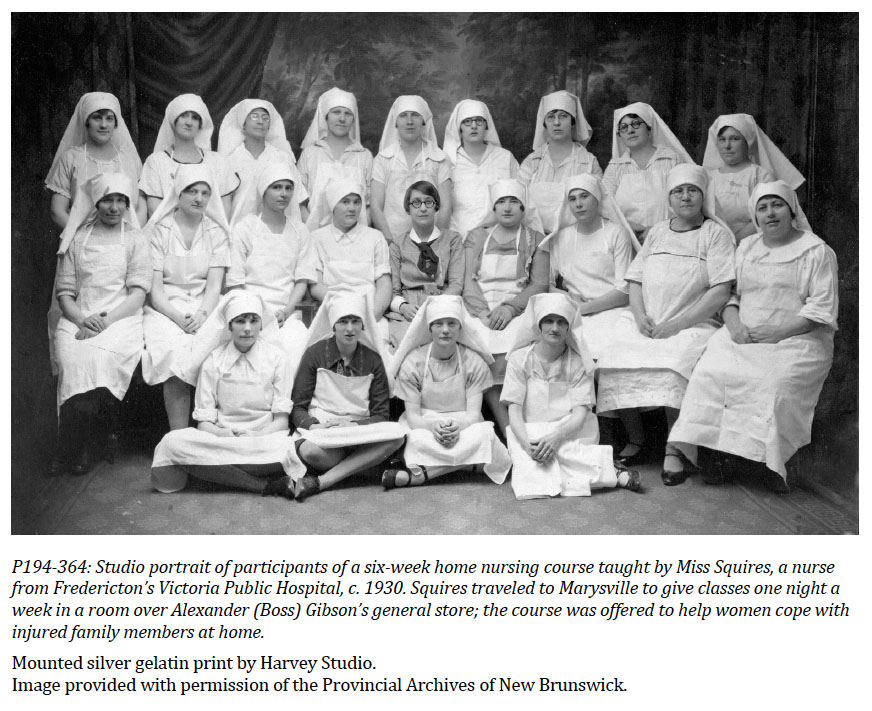 Display large image of Figure P194-364Mounted silver gelatin print by Harvey Studio.
Display large image of Figure P194-364Mounted silver gelatin print by Harvey Studio.
Image provided with permission of the Provincial Archives of New Brunswick.
P342-1143: Albert Street School children receiving polio vaccination at the time of the opening of the Polio Clinic and Health
Centre at Victoria Public Hospital in Fredericton, 1955. The previous wooden polio clinic on the Victoria Public Hospital
grounds had become woefully inadequate and was publicly criticized by many, including Dr. Everett Chalmers who commented that
the building was “a disreputable old shack” – but, he continued, “sometimes even good work can go on in a shack.”
 Display large image of Figure P342-1143Silver gelatin negative by Joe Stone.
Display large image of Figure P342-1143Silver gelatin negative by Joe Stone.
Image provided with permission of the Provincial Archives of New Brunswick.
P5-239: The corner of Queen and York Street, Fredericton, showing the area where the Provincial Normal School/Justice Building
would later be built, [1865–1875]. The large stone building is the old military hospital, and the tin shop in the foreground
was run by Andrew Napoleon LaForest. To the left, a building’s sign is partially visible, reading “Peppers.” A Thomas Peppers
is listed as an Irish trader in the 1865 assessment list.
 Display large image of Figure P5-239Collodion (wet plate) glass negative by George T. Taylor.
Display large image of Figure P5-239Collodion (wet plate) glass negative by George T. Taylor.
Image provided with permission of the Provincial Archives of New Brunswick.
P400-1: View across the Reversing Falls suspension bridge in Saint John, showing the Provincial Hospital (Provincial Lunatic
Asylum, later CentraCare), [1860–1865]. Cornerstone laid 1847, demolished 1999. This brick building superseded an older wooden
building on the same site that was constructed in 1835. A 1917 history of mental health treatment in Canada and the US proclaimed
that “to New Brunswick is due the honor of having been the first of the old British North American provinces to make special
provision for its insane.” Medical Superintendent John Waddell wrote in his 1874 annual report: “The view from the main front
eastward command the river below the Suspension Bridge, the harbour, and the City. That to the south the Bay of Fundy, and,
in clear weather, the coast of Nova Scotia; and to the north the river, with its rapids, Suspension Bridge, etc.; and the
whole is a combination probably not surpassed in variety and beauty by any landscape in America… The institution will accommodate
about two hundred patients comfortably, one hundred of each sex.”
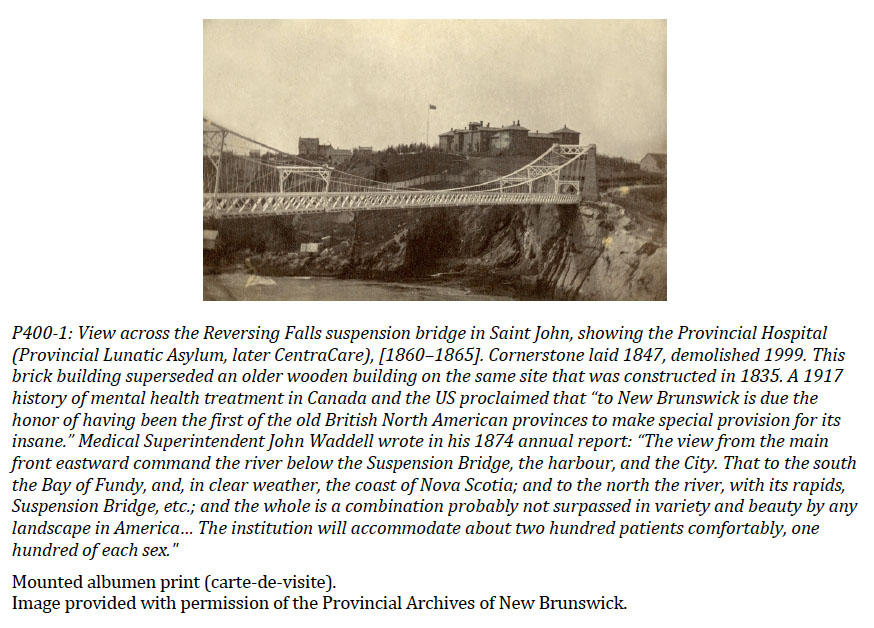 Display large image of Figure P400-1Mounted albumen print (carte-de-visite).
Display large image of Figure P400-1Mounted albumen print (carte-de-visite).
Image provided with permission of the Provincial Archives of New Brunswick.
P210-1029: Old General Public Hospital viewed from below on City Road, Saint John, 1906. This hospital (in use 1865 to c.1930)
sat between Waterloo Street and City Road until it was replaced by the Saint John General Hospital, which was spectacularly
imploded in 1995. Note the seated group at left and the man in the doorway in the centre, possibly emptying dust or ashes.
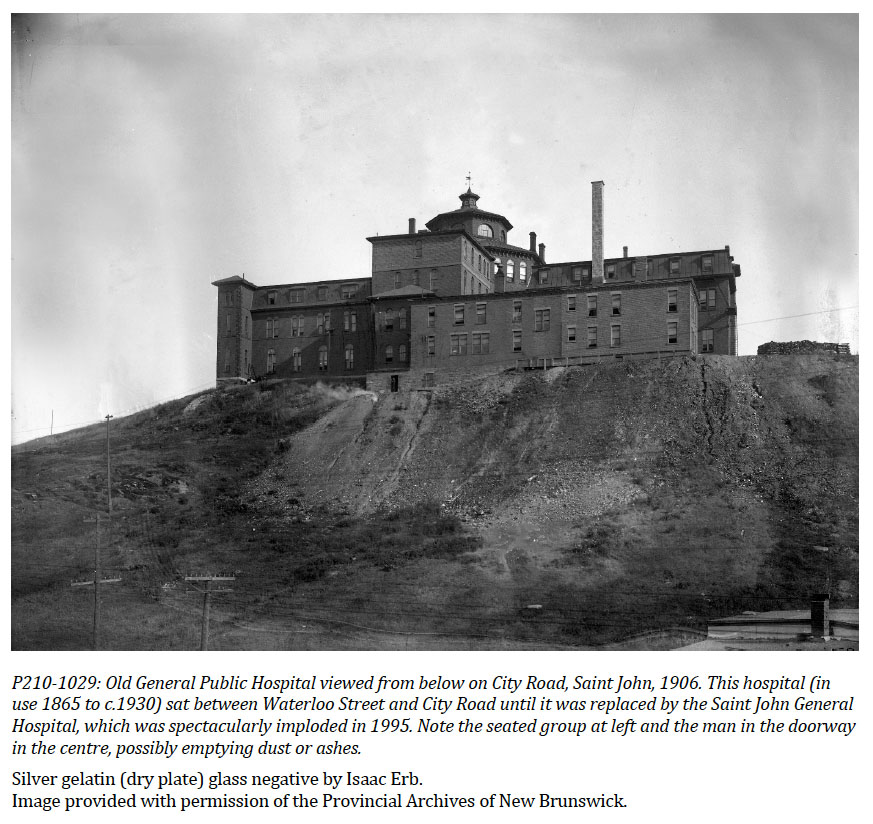 Display large image of Figure P210-1029Silver gelatin (dry plate) glass negative by Isaac Erb.
Display large image of Figure P210-1029Silver gelatin (dry plate) glass negative by Isaac Erb.
Image provided with permission of the Provincial Archives of New Brunswick.
P210-3098: Medical officers at Camp Sussex, New Brunswick’s primary military training ground prior to CFB Gagetown, 1910.
Both 8 Field Ambulance (Saint John) and 9 Field Ambulance (Charlottetown) were present in camp in 1910, as were details of
the Permanent Army Medical Corps.
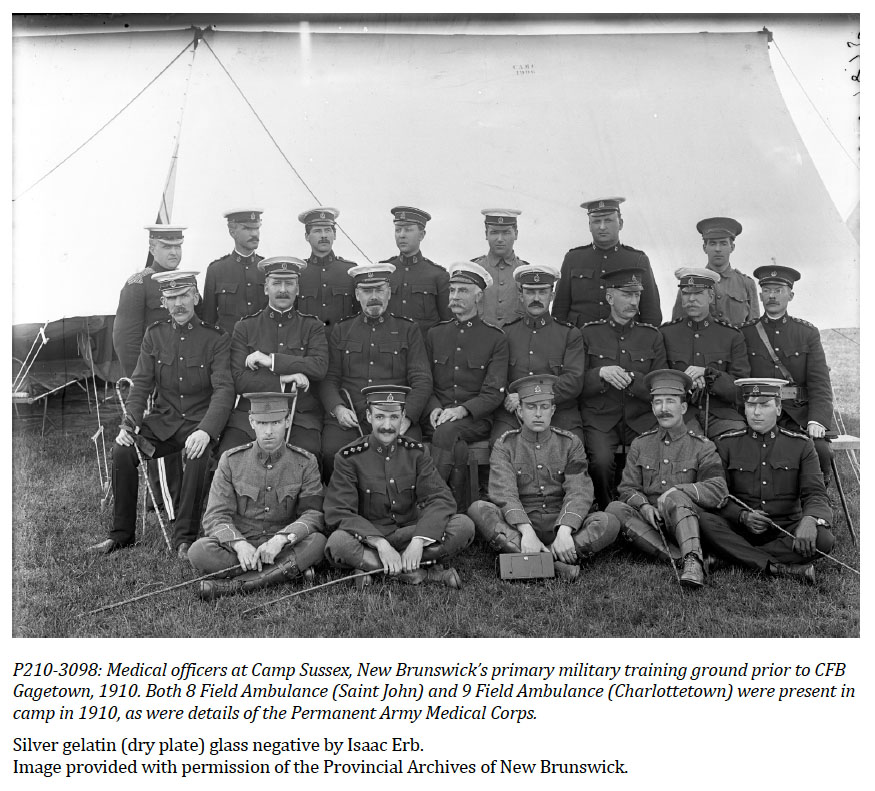 Display large image of Figure P210-3098Silver gelatin (dry plate) glass negative by Isaac Erb.
Display large image of Figure P210-3098Silver gelatin (dry plate) glass negative by Isaac Erb.
Image provided with permission of the Provincial Archives of New Brunswick.
P210-2936: Interior of Riecker’s Pharmacy in Saint John, 1911. Some of the products on display are cough syrup, Ganong chocolates,
shaving brushes, tooth paste, various products from Colgate, malt milk, bromo seltzer, and medical implements.
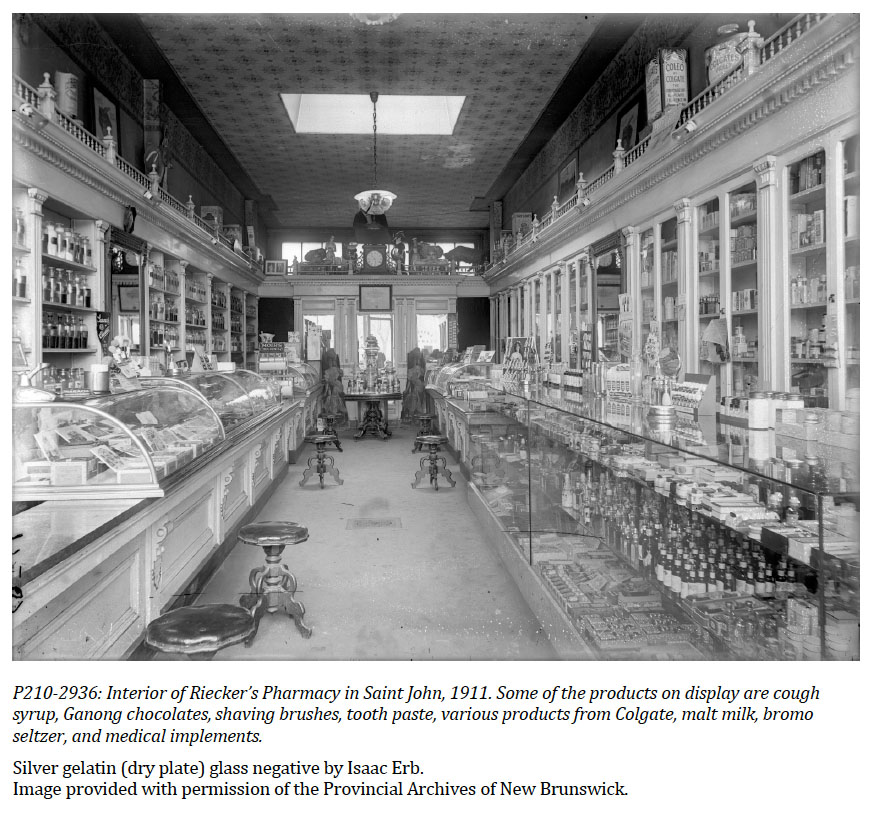 Display large image of Figure P210-2936Silver gelatin (dry plate) glass negative by Isaac Erb.
Display large image of Figure P210-2936Silver gelatin (dry plate) glass negative by Isaac Erb.
Image provided with permission of the Provincial Archives of New Brunswick.
P249-36: “A group of our new drivers on the L of C,” c. 1915, shows female Canadian Army Medical Corps drivers sitting on
a military truck during World War I, possibly near Le Touquet, France.
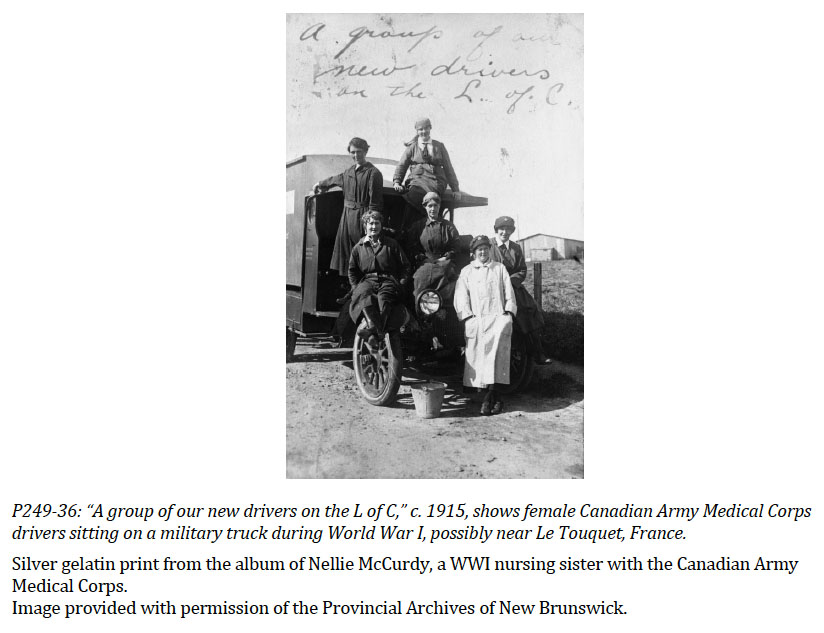 Display large image of Figure P249-36Silver gelatin print from the album of Nellie McCurdy, a WWI nursing sister with the Canadian Army Medical Corps.
Display large image of Figure P249-36Silver gelatin print from the album of Nellie McCurdy, a WWI nursing sister with the Canadian Army Medical Corps.
Image provided with permission of the Provincial Archives of New Brunswick.
P46-561: Dr. Prescott’s Private Hospital, Woodstock, c. 1916. Note nurses standing on the roof. Even into the 20th century, doctors established private hospitals throughout New Brunswick in converted hotels, private homes, and other buildings.
These existed in rural and urban areas, sometimes co-existing alongside public hospitals, sometimes standing in for them in
their absence. Dr. Prescott purchased this still-extant (c. 1840) home at 712 Main Street in 1909 for use as a private hospital,
which he ran until 1927.
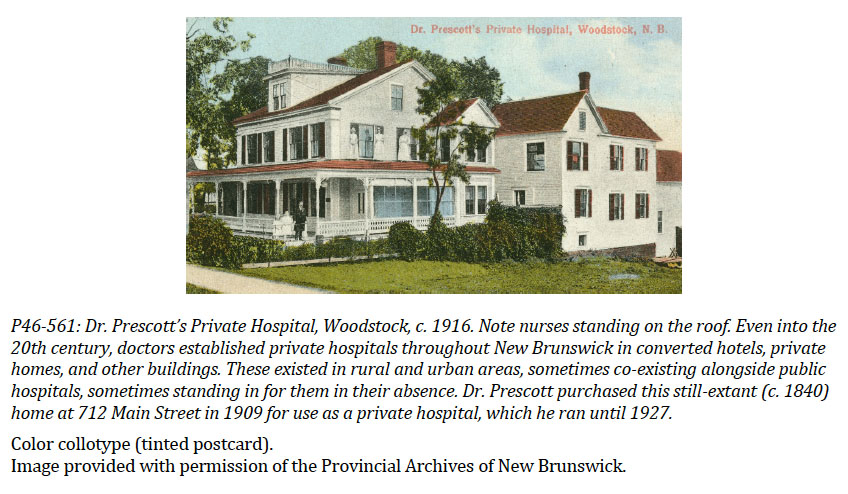 Display large image of Figure P46-561Color collotype (tinted postcard).
Display large image of Figure P46-561Color collotype (tinted postcard).
Image provided with permission of the Provincial Archives of New Brunswick.
Joshua Green is the Photo Archivist at the Provincial Archives of New Brunswick.